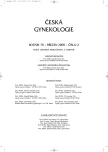Clinical Experience with a Modified Method of Human Embryo Vitrification
Authors:
R. Hredzák 1; A. Ostró 1; V. Ždilová 1; S. Toporcerová 1; J. Kačmárik 2
Authors‘ workplace:
Centrum asistovanej reprodukcie, II. gynekologicko-pôrodnícka klinika LF UPJŠ a FN L. Pasteura, Košice
prednosta doc. MUDr. A. Ostró, CSc.
1; Klinika pôrodníctva, gynekológie a andrológie, Univerzita veterinárskeho lekárstva, Košice, prednosta prof.
MVDr. J. Kačmárik, PhD.
2
Published in:
Ceska Gynekol 2005; 70(2): 99-103
Category:
Original Article
Overview
Objective:
To obtain clinical experience with a modified method of vitrification used to freeze supernumerary human embryos following in vitro fertilization (IVF) and intracytoplasmic sperm injection (ICSI).
Setting:
Centre of Assisted Reproduction, 2nd gynaecological-obstetrical clinic of Faculty hospital of L. Pasteur and Medical Faculty of the University of P. J. Šafárik, Košice.
Methods:
A modified method of vitrification was used to freeze 215 human embryos after IVF-ICSI, obtained in 42 cycles. The embryos were frozen at 48 h after in vitro culturing. The modified method of vitrification consisted in the use of a series of solutions with increasing cryoprotectant concentrations (ethylene glycol and sucrose) up to the final concentration of 40% ethylene glycol and 1 M sucrose. A 100 μl pipetting „tip” was used as a freezing container. The embroys were thawed at room temperature and the cryoprotectant was washed out three consecutive steps with sucrose solutions of decreasing concentrations (1 M, 0.5 M, and the pure medium). The morphology of embryos was evaluated before and after thawing. After thawing, the embryos were cultured in vitro for 24 hours and only the embryos with at least one cleaved blastomere were used for transfer.
Results:
The percentage of embryos which survived thawing and were capable of further development was 69.8% and 48%, respectively. The mean number of transferred and developing embryos was 2.9±1.4. The percentage of clinical pregnancies per thawing cycle and per transfer was 19.0% and 27.6%, respectively. Seven patients delivered 8 children.
Conclusion:
The results showed that our modification of vitrification procedure of human embryos is reliable and represents a simpler, shorter and cheaper alternative to slow-rate freezing.
Key words:
human embryo, ICSI, vitrification, cryoprotectant
Labels
Paediatric gynaecology Gynaecology and obstetrics Reproduction medicineArticle was published in
Czech Gynaecology

2005 Issue 2
Most read in this issue
- Coagulation Factor VIII in the Early Postpartum Period
- Abdominal Radical Trachelectomy – Technique and Experience
- Morgagni Cyst within Tubal Lipoma
- Giant Benign Mucinous Cystadenoma of Both Ovaries in Early Puerperium: Case Report and Review of Literature
